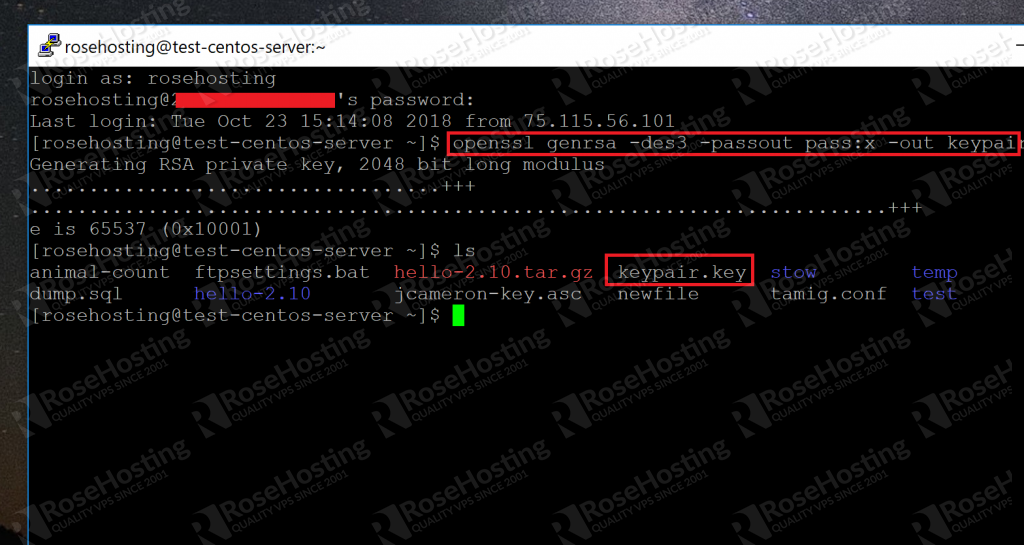Avg pc tuneup 2016 product key generator problems. It has many enhanced highlights.
Generate a new key for filevault 2 7. While Encrypting a File with a Password from the Command Line using OpenSSLis very useful in its own right, the real power of the OpenSSL library is itsability to support the use of public key cryptograph for encrypting orvalidating data in an unattended manner (where the password is not required toencrypt) is done with public keys.
Rivate key is normally encrypted and protected with a passphrase or password before the private key is transmitted or sent. When you receive an encrypted private key, you must decrypt the private key in order to use the private key together with the public server certificate to install and set up a working SSL, or to use the private key to decrypt the SSL traffic in a network protocol.
The Commands to Run

Generate a 2048 bit RSA Key
You can generate a public and private RSA key pair like this:
openssl genrsa -des3 -out private.pem 2048
That generates a 2048-bit RSA key pair, encrypts them with a password you provideand writes them to a file. You need to next extract the public key file. You willuse this, for instance, on your web server to encrypt content so that it canonly be read with the private key.
Export the RSA Public Key to a File
This is a command that is
when you are performing Git operations from your local machine. when another system or process needs access to repositories in Bitbucket Server (for example your build server)The SSH key needs to be added to Bitbucket Server, and your Bitbucket Server administrator must have to Git repositories, before you can make use of the key.Bitbucket Server supports DSA, RSA2, and Ed25519 key types. RSA1 is not supportedYou can use an existing SSH key with Bitbucket Server if you want, in which case you can go straight to either. Rhel generate ssh key. This page describes how to create SSH keys.SSH keys can be used to establish a secure connection with Bitbucket Server for:.
openssl rsa -in private.pem -outform PEM -pubout -out public.pem
The -pubout flag is really important. Be sure to include it.
Next open the public.pem and ensure that it starts with-----BEGIN PUBLIC KEY-----. This is how you know that this file is thepublic key of the pair and not a private key.
To check the file from the command line you can use the less command, like this:
less public.pem
This post will be pretty straightforward and will cover Windows, Mac, and Linux, so if you don’t know how to do it already, read on. Windows 7 generate ssh key for git.
Do Not Run This, it Exports the Private Key
A previous version of the post gave this example in error.
Openssl Genrsa Des3 No Password
openssl rsa -in private.pem -out private_unencrypted.pem -outform PEM
The error is that the -pubout was dropped from the end of the command.That changes the meaning of the command from that of exporting the public keyto exporting the private key outside of its encrypted wrapper. Inspecting theoutput file, in this case private_unencrypted.pem clearly shows that the keyis a RSA private key as it starts with -----BEGIN RSA PRIVATE KEY-----.
Visually Inspect Your Key Files
It is important to visually inspect you private and public key files to makesure that they are what you expect. OpenSSL will clearly explain the nature ofthe key block with a -----BEGIN RSA PRIVATE KEY----- or -----BEGIN PUBLIC KEY-----.
You can use less to inspect each of your two files in turn:
less private.pemto verify that it starts with a-----BEGIN RSA PRIVATE KEY-----less public.pemto verify that it starts with a-----BEGIN PUBLIC KEY-----

The next section shows a full example of what each key file should look like.
The Generated Key Files
The generated files are base64-encoded encryption keys in plain text format.If you select a password for your private key, its file will be encrypted withyour password. Be sure to remember this password or the key pair becomes useless.
The private.pem file looks something like this:
The public key, public.pem, file looks like:
Protecting Your Keys
Depending on the nature of the information you will protect, it’s important tokeep the private key backed up and secret. The public key can be distributedanywhere or embedded in your web application scripts, such as in your PHP,Ruby, or other scripts. Again, backup your keys!
Remember, if the key goes away the data encrypted to it is gone. Keeping aprinted copy of the key material in a sealed envelope in a bank safety depositbox is a good way to protect important keys against loss due to fire or harddrive failure.
Oh, and one last thing.
If you, dear reader, were planning any funny business with the private key that I have just published here. Know that they were made especially for this series of blog posts. I do not use them for anything else.
Openssl Remove Key Passphrase
Found an issue?
Rietta plans, develops, and maintains applications.
Learn more about our services or drop us your email and we'll e-mail you back.